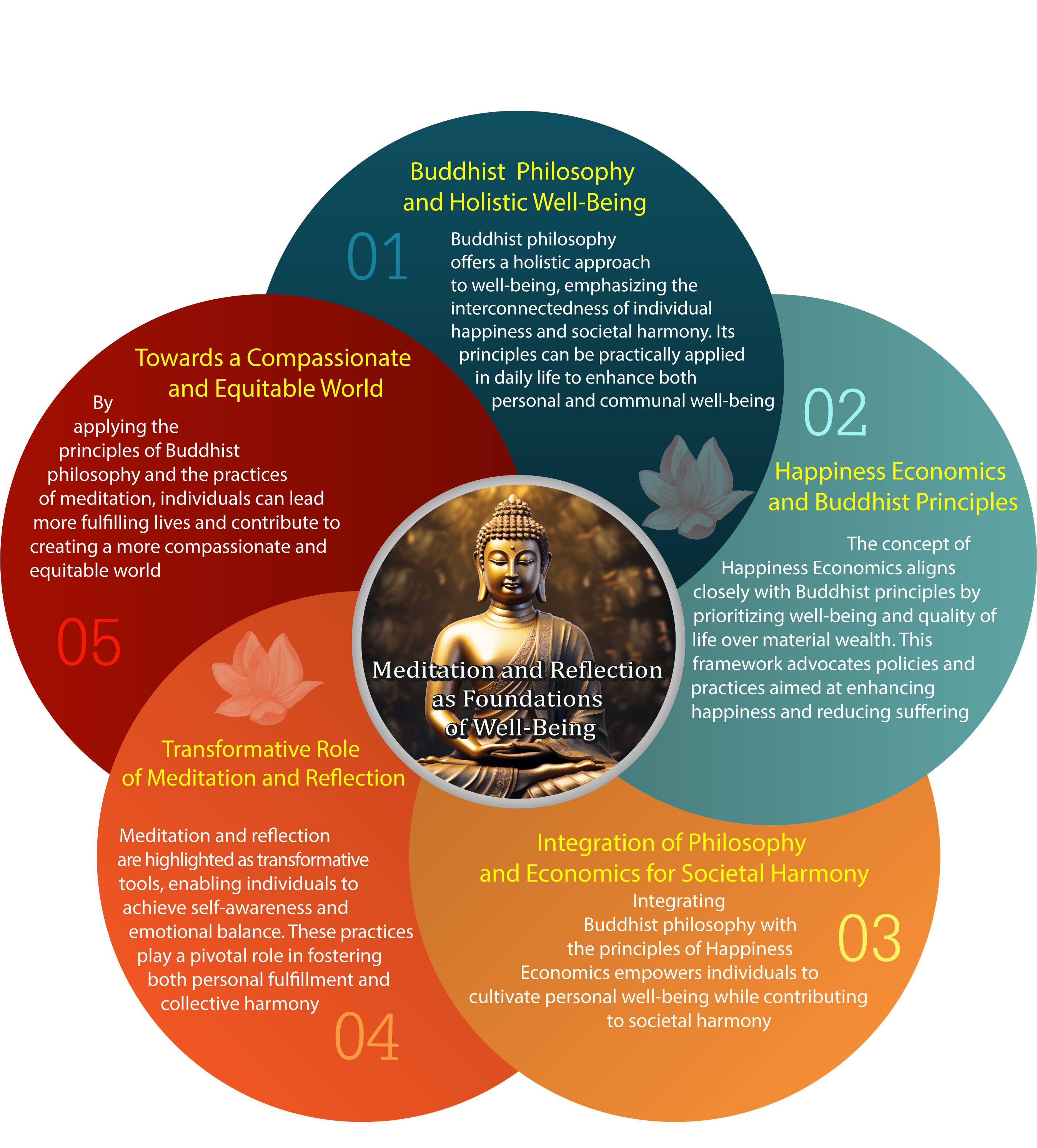Meditation and Happiness Management by Applying Buddhist Principles in the Happiness Economics
Main Article Content
Abstract
The purposes of this research were: 1) to examine the application of Buddhist principles through meditation in promoting happiness within the framework of Happiness Economics, 2) to assess the impact of meditation on stress management and emotional resilience among second-year and third-year undergraduate students, 3) to explore the connection between Buddhist teachings and modern concepts of well-being, focusing on mindfulness practices in education, and 4) to evaluate the potential of mindfulness-based interventions for enhancing mental health and resilience among students at the College of Intelligent Science and Control Engineering, Jingling Technology Institute. The research utilizes a sample group of 2,000 Chinese students to evaluate the effectiveness of meditation practices in achieving these outcomes. The research employs a Mixed Methodology approach to collect both quantitative and qualitative data from Chinese undergraduate students from the College of Intelligent Science and Control Engineering, Jingling Technology Institute. Research instruments include questionnaires measuring stress, emotional resilience, and life satisfaction, alongside in-depth interviews with 334 Chinese undergraduate students.
The results revealed that: meditation plays a crucial role in promoting sustainable happiness and emotional resilience. In-depth interviews revealed three key impacts: 1) Increased Self-Awareness, helping participants better understand their emotions and needs. 2) Stress Reduction, with regular practice significantly lowering stress levels. 3) Enhanced Well-Being, contributing to greater life satisfaction and overall well-being.
Article Details

This work is licensed under a Creative Commons Attribution-NonCommercial-NoDerivatives 4.0 International License.
เพื่อให้เป็นไปตามกฎหมายลิขสิทธิ์ ผู้นิพนธ์ทุกท่านต้องลงลายมือชื่อในแบบฟอร์มใบมอบลิขสิทธิ์บทความ ให้แก่วารสารฯ พร้อมกับบทความต้นฉบับที่ได้แก้ไขครั้งสุดท้าย นอกจากนี้ ผู้นิพนธ์ทุกท่านต้องยืนยันว่าบทความ ต้นฉบับที่ส่งมาตีพิมพ์นั้น ได้ส่งมาตีพิมพ์เฉพาะในวารสาร วิชาการธรรม ทรรศน์ เพียงแห่งเดียวเท่านั้น หากมีการใช้ ภาพหรือตารางของผู้นิพนธ์อื่นที่ปรากฏในสิ่งตีพิมพ์อื่นมาแล้ว ผู้นิพนธ์ต้องขออนุญาตเจ้าของลิขสิทธิ์ก่อน พร้อมทั้ง แสดงหนังสือที่ได้รับการยินยอมต่อบรรณาธิการ ก่อนที่บทความจะได้รับการตีพิมพ์References
Cameron, K. S., & Spreitzer, G. (2012). The Oxford Handbook of Positive Organizational Scholarship. New York: Oxford University Press.
Deci, E. L., & Ryan, R. M. (2008). Self-Determination Theory: A Macrotheory of Human Motivation, Development, and Health. Canadian Psychology, 49, 182-185. http://dx.doi.org/10.1037/a0012801
Diener, E., & Seligman, M. E. P. (2004). Beyond money: Toward an economy of well-being. Psychological Science in the Public Interest, 5(1), 1-31. https://doi.org/10.1111/j.0963-7214.2004.00501001.x
Fredrickson, B. L. (2001). The role of positive emotions in positive psychology: The broaden-and-build theory of positive emotions. American Psychologist, 56(3), 218-226. https://doi.org/10.1037/0003-066X.56.3.218
Goldstein, J. (2013). Mindfulness: A Practical Guide to Awakening. Retrieved from https://www.buddhistinquiry.org/article/mindfulness-a-practical-guide-to-awakening/
Goleman, D. (2013). Destructive Emotions: A Scientific Dialogue with the Dalai Lama. New York: A Division of Randam House, Inc.
Harvey, P. (2012). An introduction to Buddhism: Teachings, history and practices. Cambridge University Press.
Helliwell, J. F., Layard, R., Sachs, J. D., & De Neve, J.-E. (2020). World happiness report 2020. New York: sustainable development solutions network.
Kabat-Zinn, J. (1990). Full catastrophe living: Using the wisdom of your body and mind to face stress, pain, and illness. New York: Dell Publishing.
Krekel, C., Ward, G., & De Neve, J.-E. (2019). Employee Wellbeing, Productivity, and Firm Performance. Retrieved from https://ssrn.com/abstract=3356581
Layard, R. (2005). Happiness: Lessons from a new science. London: Penguin Books.
Lazar, S. W., Kerr, C. E., Wasserman, R. H., Gray, J. R., Greve, D. N., Treadway, M. T., McGarvey, M., Quinn, B. T., Dusek, J. A., Benson, H., Rauch, S. L., Moore, C. I., & Fischl, B. (2005). Meditation experience is associated with increased cortical thickness. Neuroreport, 16(17), 1893-1897. https://doi.org/10.1097/01.wnr.0000186598.66243.19
Lazarus, R. S., & Folkman, S. (1986). Cognitive theories of stress and the issue of circularity. Dynamics of stress: Physiological, psychological and social perspectives.
Lyubomirsky, S. (2007). The How of Happiness: A Scientific Approach to Getting the Life You Want. New York: Penguin Press.
Phra Brahmagunabhorn (P. A. Payutto). (2014). The Human Manual. Bangkok: Phalittham. [In Thai].
Ryff, C. D., & Singer, B. (1998). The contours of positive human health. Psychological Inquiry, 9(1), 1-28. https://doi.org/10.1207/s15327965pli0901_1
Seligman, M. E. P. (2011). Flourish: A Visionary New Understanding of Happiness and Well-being. New York: Free Press.
Shapiro, S. L., & Carlson, L. E. (2010). The art and science of mindfulness: Integrating mindfulness into psychology and the helping professions. Mindfulness 1, 64-66. https://doi.org/10.1007/s12671-010-0002-9
